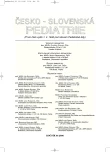Differential Diagnostics of Coagulation Disorders at the Child Age
Authors:
K. Toušovská
Authors‘ workplace:
Klinika dětské onkologie, pracoviště dětské medicíny, FN Brno
přednosta doc. MUDr. J. Štěrba, PhD.
Published in:
Čes-slov Pediat 2006; 61 (3): 137-145.
Category:
Postgraduate Education
Overview
Hemostasis is a complex multistage cascade of enzyme reactions, where the first impulse is the damage to endothelium integrity and the result is the development of a thrombus with simultaneous triggering of anticoagulant and fibrinolytic activity. The original theory of coagulation cascade as a linear enzyme reaction has been replaced by the model of an active network of simultaneously proceeding feed-back interactions. The tissue factor plays a key role in initial activation. The examination procedure of bleeding disorders in children includes, at the first place, anamnesis and physical examination. The examination of thrombocyte number is the particular coagulation test sufficient of rapid differential diagnosis within the framework of a complex blood count, activated partial prothrombine test and prothrombine time. Other tests should be indicated specifically on the basis of clinical suspicion. A flat (general) laboratory coagulation screening of children before adenotomy and, especially, the healthy children before a planned surgical intervention appears to be questionable under the present knowledge. Therefore, a standardized anamnesis and physical examination should be given priority.
Key words:
coagulopathy, pediatrics, examination, operation, adenotomy
Labels
Neonatology Paediatrics General practitioner for children and adolescentsArticle was published in
Czech-Slovak Pediatrics

2006 Issue 3
Most read in this issue
- X-linked Adrenoleukodystrophy in Twenty One Czech Patients
- Differential Diagnostics of Coagulation Disorders at the Child Age
- Alarm Treatment for Monosymptomatic Nocturnal Enuresis
- Follow-up of Children with Unilateral Multicystic Dysplasia of Kidney
